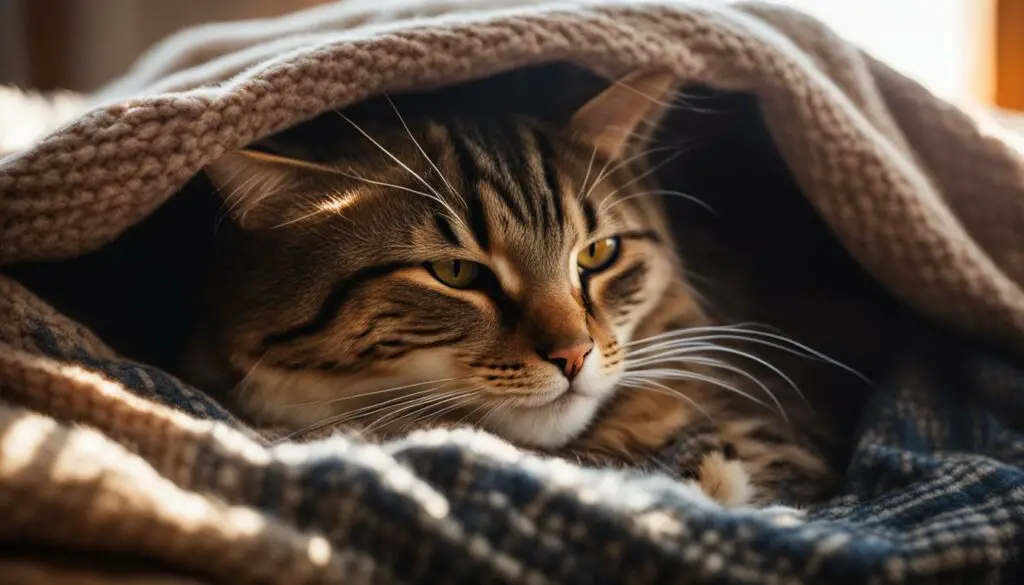Welcome to my blog where I’ll be exploring the fascinating nesting behavior of cats. From creating cozy beds to preparing for the arrival of new kittens, nesting is a natural and instinctual behavior that provides cats with a sense of security and comfort. Whether you’re a cat owner or simply curious about our feline friends, join me as we delve into the world of nesting cats and uncover the joy and wonder they bring to our homes.
Key Takeaways:
- Nesting behavior in cats involves creating a cozy and comfortable spot to rest, sleep, or prepare for giving birth.
- Cats exhibit nesting behavior as an instinctual way to seek security, warmth, and relaxation.
- Pregnant cats typically start nesting in the final weeks of their pregnancy.
- Excessive or compulsive nesting behavior may indicate underlying stress or anxiety.
- Creating a loving and supportive home environment can enhance the nesting experience for cats.
What is Nesting Behavior in Cats?
Nesting behavior in cats refers to their natural instinct of creating a cozy and comfortable spot to rest, sleep, or prepare for giving birth. Cats gather soft materials like blankets, towels, or clothing and knead them with their paws to construct a comfortable bed. This behavior is most commonly observed in pregnant cats preparing for birth, but non-pregnant cats may also exhibit nesting behavior when seeking a comfortable resting spot. Nesting provides cats with a sense of security and comfort and is a way for them to feel safe and relaxed.
Nesting behavior is driven by the instinctual need for warmth and coziness. It is a behavior that is deeply ingrained in cats, inherited from their wild ancestors who created nests to keep themselves and their kittens warm and protected from predators. By creating a nest, cats can replicate the feeling of safety and security that they would experience in the wild.
Non-pregnant cats may exhibit nesting behavior as a way to seek comfort and relaxation. They may choose to nest in a specific spot in the house, such as a favorite chair or a cozy corner, where they feel safe and comfortable. This behavior is perfectly normal and is not necessarily indicative of any underlying health issues.
Overall, nesting behavior in cats is a natural and instinctual behavior that provides them with a sense of security and comfort. Whether exhibited by pregnant cats preparing for birth or non-pregnant cats seeking a cozy resting spot, nesting behavior is a common occurrence and an important aspect of feline behavior.
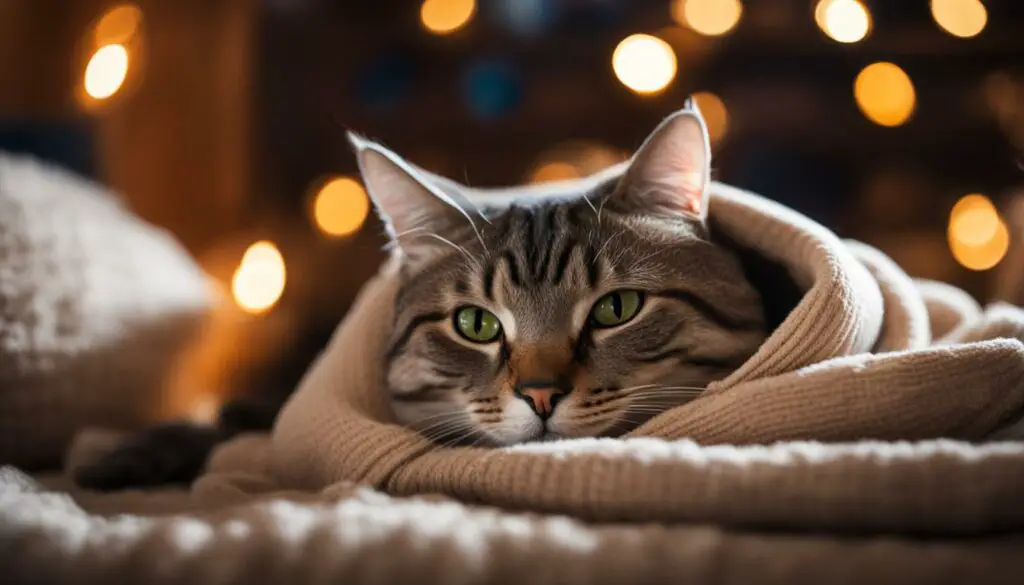
What Influences Nesting Behavior in Cats?
Several factors can influence a cat’s nesting behavior. One of the main factors is their instinctual need for warmth and coziness. Cats are naturally drawn to soft, warm materials and will seek them out to create a nest. Providing your cat with comfortable bedding, such as blankets or a cat bed, can encourage nesting behavior.
Another factor that can influence nesting behavior is the cat’s environment. Cats seek out safe and cozy spots to rest and sleep, so creating a quiet and secure environment can encourage nesting. Additionally, the presence of other pets or family members can influence a cat’s nesting behavior. Some cats may be more inclined to nest when they are seeking solitude, while others may prefer to nest in close proximity to their human or animal companions.
It is important to note that not all cats will exhibit nesting behavior, as individual preferences and personalities can vary. Some cats may have a stronger nesting instinct than others, while some may not exhibit nesting behavior at all. It is important to respect and understand your cat’s individual needs and preferences when it comes to nesting behavior.
Why Do Cats Exhibit Nesting Behavior?
Cats exhibit nesting behavior for several reasons. One reason is that it is an instinctual behavior inherited from their wild ancestors. In the wild, cats created nests to keep themselves and their kittens warm and protected from predators. Nesting behavior also provides cats with a sense of security and comfort. Cats are known for their love of warmth and coziness, and creating a nest is a way for them to feel safe and relaxed.
Additionally, nesting behavior can also be a way for cats to mark their territory. By kneading soft materials and leaving their scent on them, cats establish ownership and signal to other cats that the area is taken. This territorial aspect of nesting behavior is more commonly seen in non-pregnant cats, as they do not have the added motive of preparing for birth.
Overall, nesting behavior in cats is a natural instinct that serves multiple purposes, including providing warmth, comfort, security, and establishing territorial boundaries. Understanding and supporting this behavior can help create a loving and nurturing environment for our feline companions.
When Do Cats Start Nesting?
Understanding when cats start nesting can provide valuable insights into their reproductive and instinctive behaviors. While nesting behavior can be observed in cats of all ages, it is most commonly seen in pregnant cats preparing for birth.
Typically, pregnant cats begin nesting in the final weeks of their pregnancy, which is usually around one to two weeks before giving birth. This instinctual behavior serves as a preparation for the arrival of their kittens, ensuring a safe and warm environment for them.
It’s important to note that non-pregnant cats may also exhibit nesting behavior when seeking a comfortable resting spot. Cats, regardless of their reproductive status, instinctively create a cozy and secure space by kneading soft materials like blankets, towels, or clothing with their paws.
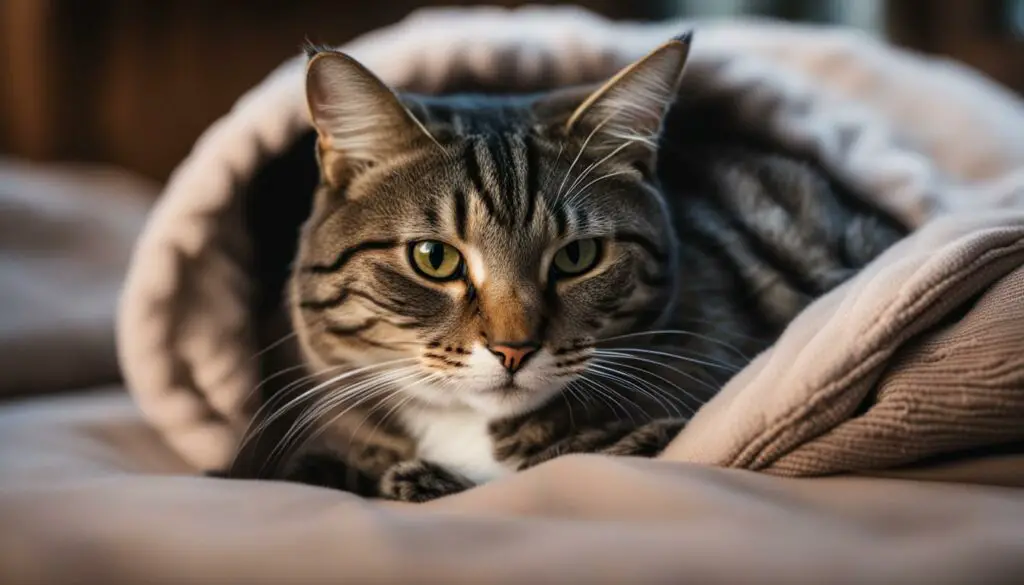
When Do Cats Start Nesting?
| Pregnant Cats | In the final weeks of pregnancy, around one to two weeks before giving birth |
|---|---|
| Non-Pregnant Cats | At any age, when seeking a comfortable resting spot |
“Understanding when cats start nesting can provide valuable insights into their reproductive and instinctive behaviors.”
Nesting behavior in cats is a natural and instinctual behavior that allows them to create a safe and comfortable space. By observing their nesting behavior, cat owners can gain a better understanding of their feline companions and provide the necessary support and comfort they need during this time.
When is Nesting Behavior in Cats a Cause for Concern?
In most cases, nesting behavior in cats is normal and not cause for concern. However, there are some instances when nesting may indicate an underlying issue. If a cat suddenly starts nesting more frequently than usual, it may indicate stress, anxiety, or pregnancy. Changes in the home environment, such as introducing a new pet or family member, can cause cats to feel anxious and seek comfort through nesting behavior. Nesting behavior can also be a sign of illness or injury, and if a cat exhibits unusual symptoms or behaviors along with nesting, it’s important to schedule a checkup with a veterinarian.
It’s important to monitor your cat’s nesting behavior and look for any changes or patterns. If you notice that your cat is nesting excessively or obsessively, it may be a sign of an underlying issue that needs to be addressed. Excessive nesting can indicate stress, anxiety, or even a condition known as nesting cat syndrome. This syndrome is characterized by compulsive nesting behavior that is unrelated to pregnancy or comfort-seeking. If you suspect that your cat may be experiencing nesting cat syndrome, it’s best to consult with a veterinarian who can provide guidance and appropriate treatment.
“Changes in nesting behavior can be a red flag for underlying health issues in cats.”
While nesting behavior in cats is generally considered normal, it’s important to be aware of any changes or abnormalities. If your cat’s nesting behavior is accompanied by other concerning symptoms such as loss of appetite, lethargy, or changes in litter box habits, it’s crucial to seek veterinary attention promptly. Regular check-ups with a veterinarian can help ensure that your cat’s nesting behavior is within normal limits and that any underlying health conditions are detected and treated early.
In summary, while nesting behavior in cats is typically normal and instinctual, it’s important to be attentive to any changes or excessive nesting that may indicate a cause for concern. By monitoring your cat’s behavior, seeking professional advice when needed, and providing a supportive environment, you can help ensure the well-being and happiness of your nesting cat.
Can You Encourage Nesting Behavior in Cats?
If you want to encourage your cat to exhibit nesting behavior, there are a few things you can do to provide them with a comforting environment. First, consider providing them with a soft and comfortable bed or blanket that they can knead and arrange to their liking. Cats love warm and cozy spots, so placing their bed in a sunny area or near a heat source can also entice them to nest. Additionally, you can try placing toys and other materials for your cat to play with while nesting, such as balls or stuffed animals.
Creating a cozy and inviting atmosphere is key to encouraging nesting behavior in cats. Make sure the nesting area is quiet and away from any loud noises or disturbances. Cats prefer a sense of privacy when nesting, so finding a secluded spot where they feel safe is important. You can also consider using pheromone sprays or diffusers, which release calming scents that can help reduce stress and anxiety in cats.
It’s important to note that not all cats will exhibit nesting behavior, even with these encouragements. Each cat is unique and may have different preferences or instincts. Some cats may prefer to nest in different areas of the house, such as under the bed or in a closet. It’s important to observe your cat’s behavior and provide them with options for nesting that suit their individual needs.
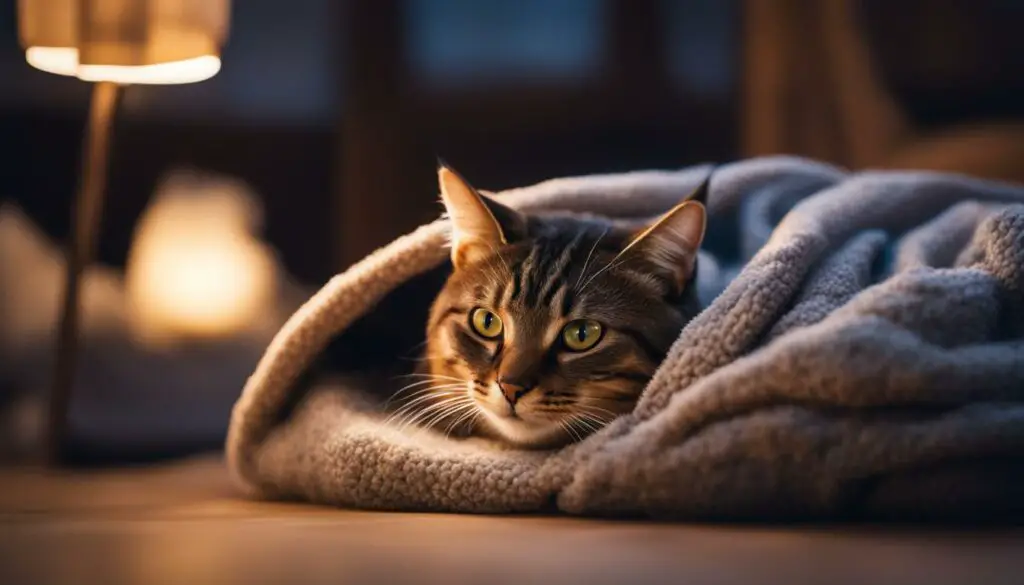
Remember, the goal is to create a comfortable and inviting space for your cat to relax and feel secure. By providing them with a cozy bed, warmth, and toys to engage with, you can encourage nesting behavior and ensure your cat feels content and comforted in their surroundings.
Nesting Cat Beds, Dolls, Trees, and Toys
When it comes to catering to the nesting behavior of cats, there are various products available in the market that can provide them with comfort and relaxation. These products are designed to cater to their natural instinct of creating a cozy and secure spot to rest or sleep. Let’s take a look at some of these products:
Nesting Cat Beds
Nesting cat beds are specifically designed to provide a snug and comfortable space for cats to curl up and relax. They are typically made of soft materials and have plush interiors to mimic the feeling of a warm and cozy nest. These beds often come in different shapes and sizes, catering to the individual preferences of cats. Some even have additional features like removable covers for easy cleaning.
Nesting Cat Dolls
Nesting cat dolls are plush toys that mimic the sensation of nesting. Cats can knead and cuddle with these dolls, providing them with a sense of comfort and security. These dolls are often filled with soft materials that cats can manipulate with their paws, simulating the act of creating a nest. They can be a great source of entertainment and companionship for cats while fulfilling their nesting instincts.
Nesting Cat Trees
Nesting cat trees provide elevated platforms and cozy hideaways for cats to nest and observe their surroundings. These trees often come with multiple levels and compartments, giving cats the option to choose their preferred nesting spot. Some cat trees also have scratching posts and toys attached, providing additional stimulation and entertainment. They are a great way to satisfy a cat’s nesting instinct while also providing them with a safe and enriching environment.
Nesting Cat Toys
Nesting cat toys, such as interactive puzzles or tunnels, can engage cats while also fulfilling their nesting instincts. These toys often have hidden compartments or cozy spaces where cats can hide and explore. They provide mental stimulation and physical exercise while allowing cats to satisfy their nesting behavior. Interactive toys can be a great way to keep cats entertained and contented while promoting their natural instinct of nesting.
Overall, these products cater to the nesting behavior of cats, providing them with a sense of security and comfort. Whether it’s a cozy bed, a plush doll, a multi-level cat tree, or an interactive toy, these items can enhance a cat’s nesting experience and contribute to their overall well-being.
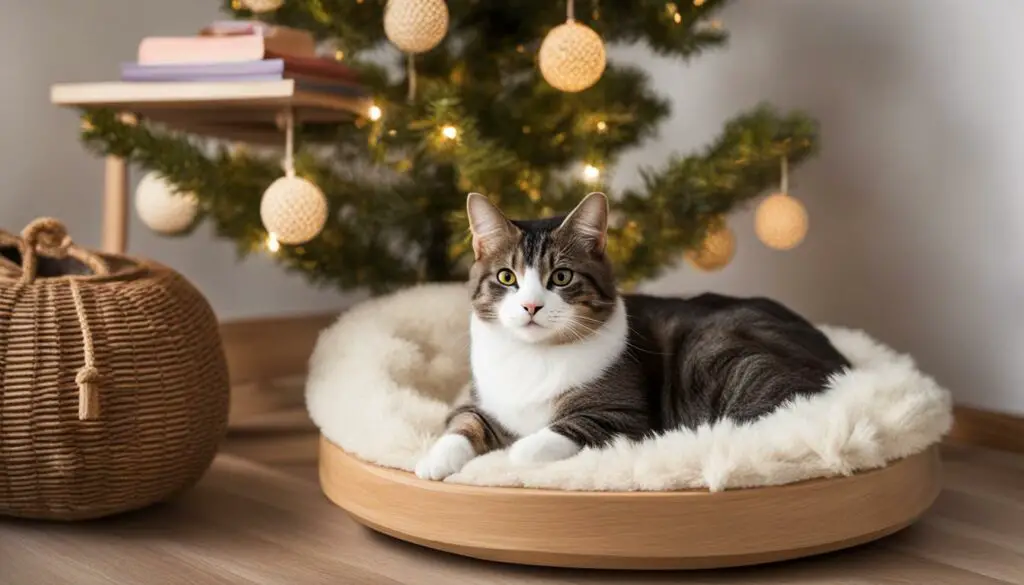
Creating the Perfect Nesting Environment
Creating the perfect nesting environment for your cat is essential to ensure their comfort and well-being. One way to achieve this is by investing in nesting cat furniture. This type of furniture is specially designed to provide your cat with cozy and secure spaces where they can indulge in their nesting instincts. Some popular options include cat trees with enclosed spaces and perches that offer a sense of security and elevated views. Additionally, cat shelves and window perches can provide elevated spots for nesting, allowing your cat to observe their surroundings while feeling safe and relaxed.
When selecting nesting cat furniture, consider the materials used. Opt for soft and comfortable fabrics that mimic the feeling of blankets or clothing. Providing designated nesting areas with soft blankets, towels, or clothing can also encourage your cat to create their own cozy nests. Placing these items in quiet and warm spots, such as near a sunny window or next to a heat source, will further enhance their appeal.
| Nesting Cat Furniture | Description |
|---|---|
| Cat Trees | Featuring enclosed spaces and elevated perches, cat trees provide a variety of nesting options for cats. |
| Cat Shelves | These shelves can be mounted on walls to create elevated nesting spots for cats. |
| Window Perches | Window perches offer a comfortable and elevated space for cats to nest while enjoying a view of their surroundings. |
By providing the right nesting cat furniture and creating a comforting environment, you can satisfy your cat’s nesting instincts and promote their overall well-being and happiness. Remember to observe your cat’s preferences and behaviors to ensure you are meeting their individual needs.
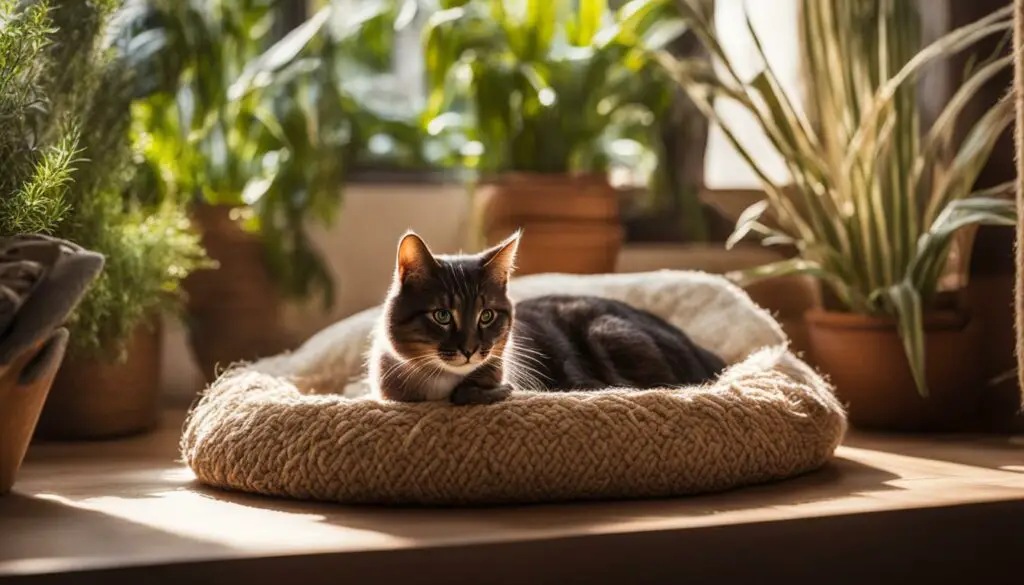
Supporting Your Cat’s Nesting Behavior
Aside from nesting cat furniture, there are other ways you can support your cat’s nesting behavior. Consider providing them with nesting cat toys, such as plush dolls or interactive puzzles, which can engage their instincts and provide additional comfort. Regularly cleaning and maintaining their nesting areas will also create a hygienic and inviting environment for your cat.
Remember, each cat is unique, and their nesting preferences may vary. Some cats may prefer cozy nooks, while others may enjoy soft beds or enclosed spaces. Take the time to understand your cat’s individual needs and preferences to create a personalized nesting environment that they will truly enjoy. By providing the perfect nesting environment, you can ensure your cat feels safe, secure, and content in their own cozy sanctuary.
Understanding Nesting Cat Behavior
Nesting behavior in cats is a fascinating instinct that provides them with a sense of security and comfort. Whether it’s a pregnant cat preparing for birth or a non-pregnant cat seeking a cozy resting spot, nesting behavior is driven by their natural instincts. Cats have an innate need for warmth, coziness, and protection, which is why they engage in nesting behavior.
By observing a cat’s nesting behavior, we can gain insights into their instinctual needs and desires. The act of kneading soft materials and creating a comfortable bed reflects their ancestral need to keep themselves and their kittens warm and protected from predators. Nesting behavior also serves as a way for cats to feel safe and relaxed in their surroundings.
However, it’s important to distinguish between normal nesting behavior and excessive or compulsive nesting behavior, also known as nesting cat syndrome. While normal nesting behavior is a sign of a content and comfortable cat, nesting cat syndrome may indicate underlying stress or anxiety. If you notice your cat exhibiting excessive nesting behavior or displaying other unusual symptoms or behaviors, it’s best to consult with a veterinarian to address any potential issues.

The Instinctual Need for Warmth and Coziness
A key aspect of nesting cat behavior is their instinctual need for warmth and coziness. Cats are known for seeking out warm spots in their environment, and creating a nest allows them to satisfy this need. By gathering soft materials and kneading them with their paws, cats create a cozy bed that provides the warmth and comfort they crave.
Understanding and respecting a cat’s nesting behavior is essential for creating a loving and supportive home environment. By providing them with soft blankets, designated nesting areas, and cozy cat beds, you can help fulfill their instinctual need for warmth and coziness. Additionally, maintaining a calm and stress-free atmosphere plays a crucial role in supporting a cat’s nesting behavior.
The Importance of Veterinary Guidance
If you have any concerns about your cat’s nesting behavior, seeking professional advice from a veterinarian is highly recommended. Vets can assess your cat’s overall health and well-being, as well as provide tailored guidance based on their specific needs. They can help determine whether your cat’s nesting behavior is normal or if there are underlying issues that need to be addressed.
Regular veterinary check-ups are essential for the overall health and happiness of nesting cats. Vets can provide valuable insights and recommendations to help support your cat’s nesting behavior, ensuring they have a safe and nurturing environment in which to thrive.
Veterinary Insights on Nesting Cat Behavior
When it comes to nesting behavior in cats, veterinarians have valuable insights to offer. As experts in feline health and behavior, they emphasize that nesting behavior is a normal and common behavior for cats. It provides them with a sense of security, comfort, and contentment. However, it’s important for cat owners to be aware of any sudden changes in nesting behavior or accompanying symptoms that may indicate underlying issues.
If a cat starts nesting more frequently than usual or exhibits unusual symptoms or behaviors, it’s advisable to schedule a checkup with a veterinarian. Vets can assess the overall health and well-being of the cat and provide guidance or recommendations to address any underlying issues or concerns related to nesting behavior. They can also offer advice on creating a safe and supportive environment for nesting cats.
“As a veterinarian, I often reassure cat owners that nesting behavior is a natural instinct and is generally nothing to worry about,” says Dr. Sara Johnson, a feline specialist. “However, it’s always important to monitor any changes in behavior and seek veterinary advice if needed. We can help determine if there are any underlying health issues or if behavioral interventions are necessary to ensure the well-being of both the cat and the owner.”
Common Veterinary Recommendations:
- Regular veterinary check-ups: This allows for early detection of any health issues and ensures the overall well-being of the cat.
- Creating a stress-free environment: Cats are sensitive creatures, and changes in their environment can cause stress. Providing a calm and stable atmosphere can help alleviate anxiety and promote nesting behavior.
- Monitoring nesting behavior: While nesting is usually normal, excessive or compulsive nesting behavior can be a sign of stress or anxiety. By monitoring and understanding the cat’s behavior, veterinarians can provide appropriate interventions and recommendations.
| Signs to Watch Out For | When to Consult a Veterinarian |
|---|---|
| Excessive or compulsive nesting behavior | When nesting behavior interferes with the cat’s daily routine or causes distress |
| Accompanying symptoms such as loss of appetite, lethargy, or changes in litter box habits | When nesting behavior is accompanied by other unusual symptoms or behaviors |
| Sudden changes in nesting behavior | If nesting behavior increases or decreases significantly without apparent cause |
By seeking veterinary advice and following their recommendations, cat owners can ensure the health and well-being of their nesting feline companions. Veterinarians play an essential role in providing professional guidance and support to address any concerns or issues related to nesting behavior, allowing both cats and their owners to enjoy a harmonious and fulfilling relationship.
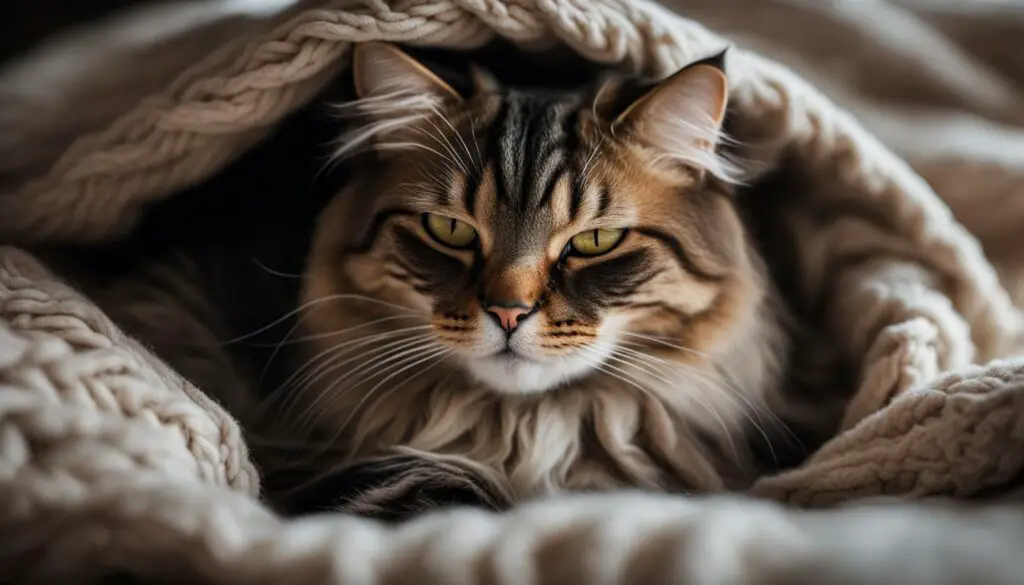
Providing Comfort and Support for a Nesting Cat
When it comes to supporting a nesting cat, creating a comfortable and safe environment is key. Cats have a natural instinct to nest, whether they are pregnant or not. By understanding their needs and providing the right resources, we can ensure their comfort and well-being.
Start by offering your cat a soft and cozy bed or blanket where they can create their nest. Choose materials that are comfortable and easy to clean. Placing the bed in a warm and quiet spot will further enhance their nesting experience. Cats love warmth, so make sure the temperature is consistent and soothing for them.
“By providing a warm and cozy environment, we can support our cat’s nesting behavior and promote their overall comfort.”
In addition to a comfortable bed, consider adding toys and other materials that can engage your cat while they are nesting. This can include scratching posts, interactive toys, and puzzle feeders. These not only provide mental stimulation but also offer a sense of security and contentment to your cat.
| Ways to Support Nesting Behavior | Benefits |
|---|---|
| Provide a soft and cozy bed or blanket | Ensures comfort and warmth |
| Place the bed in a warm and quiet spot | Creates a peaceful nesting environment |
| Offer engaging toys and materials | Promotes mental stimulation and relaxation |
Creating a Soothing Atmosphere
To further support your nesting cat, it’s important to create a calm and stress-free atmosphere. Cats are sensitive creatures, and their nesting behavior can be influenced by their environment. Minimize loud noises, keep a consistent routine, and provide hiding spots where your cat can retreat when they need some alone time. These small changes can have a big impact on your cat’s overall comfort and well-being.
Remember, each cat is unique, and their preferences may vary. Pay attention to their cues and adjust the nesting environment accordingly. By providing a warm, cozy, and supportive environment, you can ensure that your nesting cat feels safe, comfortable, and loved.
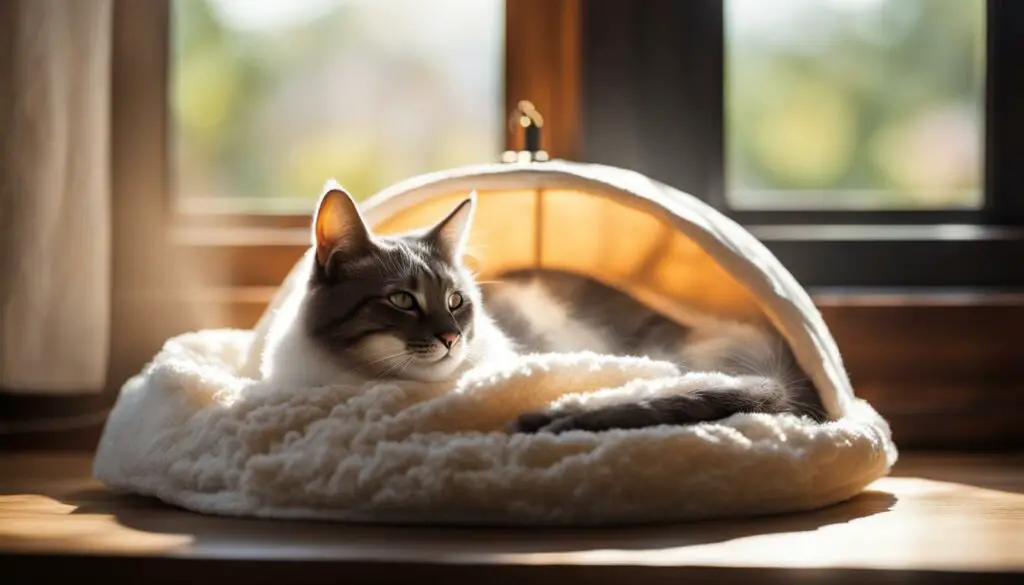
Seeking Professional Advice for Nesting Cats
If you have concerns or questions about your cat’s nesting behavior, it is always a good idea to seek professional advice from a veterinarian. Veterinary consultation can provide you with personalized guidance based on your cat’s specific needs and circumstances. Veterinarians can assess your cat’s behavior, health, and overall well-being, and offer recommendations or interventions to address any issues related to nesting behavior.
Regular veterinary check-ups and consultations are essential for ensuring the overall health and happiness of nesting cats. A veterinarian can provide insights into your cat’s nesting behavior and help determine whether it is within normal limits or potentially indicative of an underlying issue. They can also offer guidance on creating a safe and comfortable nesting environment, as well as provide recommendations for any necessary behavioral or medical interventions.
Veterinary professionals have the knowledge and expertise to provide you with the best advice and support for your nesting cat. They can help you understand your cat’s behavior and address any concerns or questions you may have. By seeking professional advice, you can ensure that your nesting cat receives the care and support they need for a happy and healthy nesting experience.
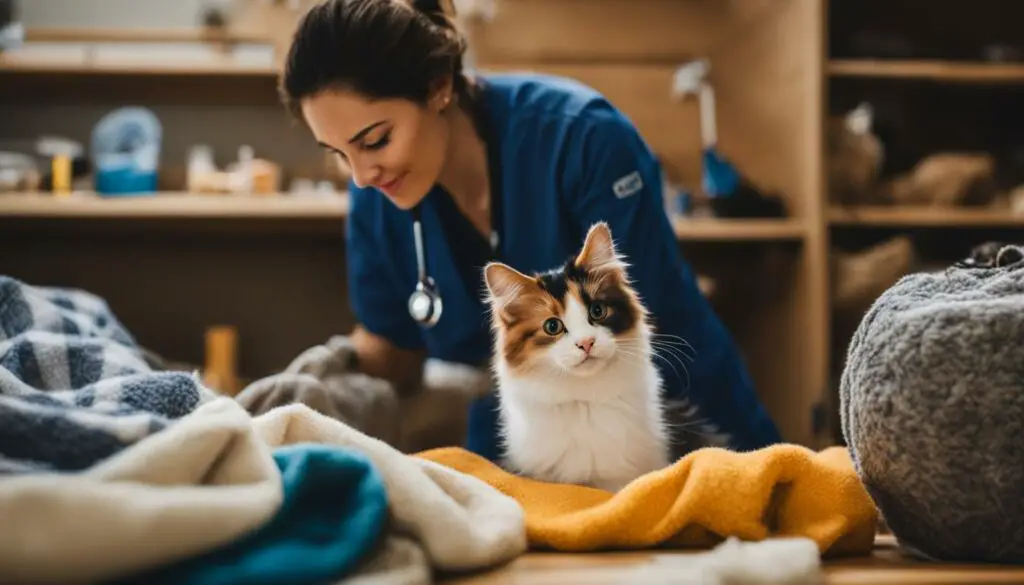
Remember, every cat is unique, and their nesting behavior may vary. It’s always best to consult with a veterinarian to receive personalized advice and guidance specific to your cat’s needs.
The Joy of Welcoming New Arrivals
Welcoming new arrivals into our homes is always a joyous occasion, and when it comes to nesting cats, it’s an experience filled with warmth and excitement. The sight of a cat diligently creating a cozy nest and the sound of tiny meows from newborn kittens can bring immense happiness and a sense of fulfillment to any household. As a cat owner, witnessing this natural instinct and behavior in action is truly a precious moment.
Nesting behavior in cats is driven by their innate instincts to create a safe and nurturing environment for their young. It’s a testament to the remarkable and loving nature of these animals. The process of nesting, from gathering soft materials to arranging them with their paws, showcases the dedication and care that cats exhibit as they prepare to welcome their new arrivals into the world.
“The joy of nesting cats resides in the anticipation and excitement that come with the arrival of new kittens,” says Dr. Emily Johnson, a veterinarian with expertise in feline behavior. “It’s a heartwarming experience to witness the mother’s instinctual drive to create a safe and comfortable haven for her little ones.”
As cat owners, we have the privilege of witnessing this joyous journey and providing support to our nesting cats. Ensuring a calm and stress-free environment, offering ample warmth and comfort, and providing regular veterinary care are all vital steps in creating a nurturing home for both the mother cat and her kittens. By understanding and appreciating the joy of nesting, we can foster a bond of love and care that will continue to flourish as we welcome new arrivals into our lives.
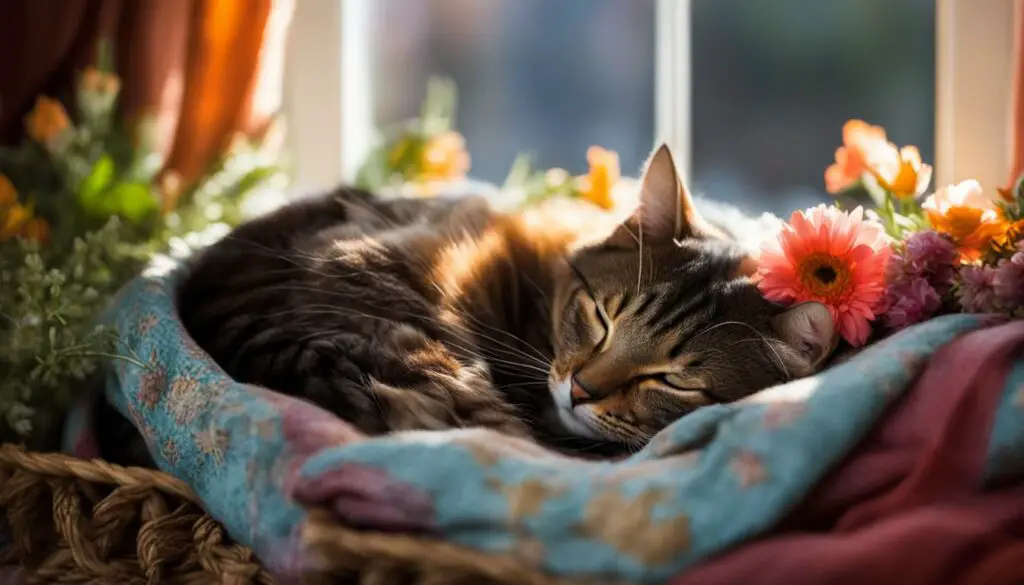
| Benefits of the Joy of Nesting | Ways to Create a Joyful Nesting Experience |
|---|---|
| 1. Creates a sense of fulfillment and happiness | 1. Provide a cozy and quiet nesting area |
| 2. Strengthens the bond between cat and owner | 2. Offer soft blankets and cushions for comfort |
| 3. Highlights the natural instincts and behaviors of cats | 3. Maintain a consistent temperature in the nesting area |
| 4. Provides an opportunity for growth and learning | 4. Ensure the nesting area is free from disturbances |
| 5. Adds warmth and joy to the household | 5. Monitor the health and well-being of the mother cat |
The joy of nesting cats is a beautiful reminder of the wonders of nature and the incredible bond we share with our feline companions. As we welcome new kittens into our homes, let us cherish and celebrate this special time, providing the love, care, and support that our nesting cats and their adorable offspring deserve.
Creating a Loving and Supportive Home for Nesting Cats
When it comes to creating a loving and supportive home for nesting cats, there are a few key factors to consider. First and foremost, providing a safe and comfortable environment is essential. This means ensuring that your cat has access to a cozy bed or blanket where they can create their own nest. Place it in a warm and quiet spot, away from any potential disturbances, to allow your cat to feel secure and at ease.
In addition to a comfortable resting place, it’s important to offer your nesting cat plenty of toys and materials to engage with. Cats enjoy playing and interacting with their surroundings, so providing toys that promote physical activity and mental stimulation can enhance their overall nesting experience. Consider interactive puzzles, scratching posts, or tunnels for your cat to explore while nesting.
Regular veterinary care is also crucial in creating a loving home for nesting cats. Schedule routine check-ups to ensure your cat’s health and well-being. Your veterinarian can provide guidance and recommendations based on your cat’s specific needs, as well as address any concerns or questions you may have about your cat’s nesting behavior.
The key to creating a loving and supportive home for nesting cats is to understand and respect their natural instincts and behaviors. By providing a safe and comfortable environment, engaging toys and materials, and regular veterinary care, you can ensure that your cat feels loved, nurtured, and content in their nesting space.
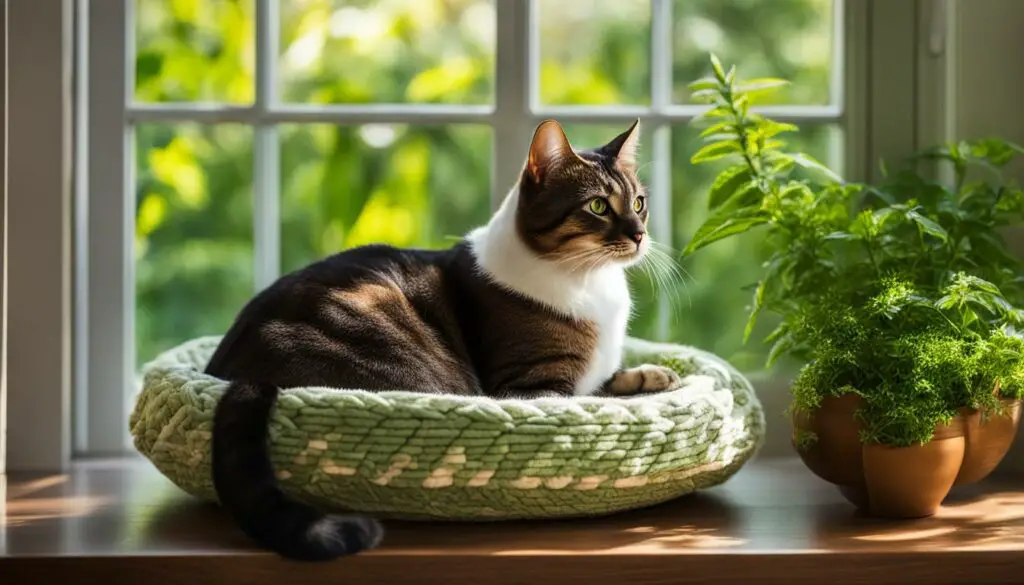
| Key Factors for a Loving Home for Nesting Cats |
|---|
| Provide a safe and comfortable environment |
| Offer plenty of engaging toys and materials |
| Ensure regular veterinary care |
| Respect and understand their natural instincts |
Conclusion
In conclusion, nesting behavior in cats is a natural instinct that provides them with a sense of security, comfort, and relaxation. Whether exhibited by pregnant cats preparing for birth or non-pregnant cats seeking a cozy resting spot, nesting behavior is a common and normal occurrence.
It is important for cat owners to understand and respect their cats’ natural instincts and behaviors. Creating a loving and supportive home environment that includes comfortable bedding, cozy spots, and engaging toys can enhance the nesting experience for cats.
If a cat exhibits excessive or compulsive nesting behavior, it could be a sign of underlying stress or anxiety. In such cases, it is advisable to seek professional advice from a veterinarian who can assess the cat’s behavior and provide guidance or interventions if necessary.
By understanding and supporting a cat’s nesting behavior, pet owners can create a nurturing space that promotes the overall happiness and well-being of their feline companions.
FAQ
What is nesting behavior in cats?
Nesting behavior in cats refers to their natural instinct of creating a cozy and comfortable spot to rest, sleep, or prepare for giving birth. Cats gather soft materials like blankets, towels, or clothing and knead them with their paws to construct a comfortable bed.
Why do cats exhibit nesting behavior?
Cats exhibit nesting behavior as an instinctual behavior inherited from their wild ancestors. Nesting provides cats with a sense of security and comfort, and it is a way for them to feel safe and relaxed.
When do cats start nesting?
Cats can start exhibiting nesting behavior at any age. However, nesting behavior is most commonly observed in pregnant cats preparing for birth. Pregnant cats typically start nesting in the final weeks of their pregnancy, usually around one to two weeks before giving birth.
When is nesting behavior in cats a cause for concern?
In most cases, nesting behavior in cats is normal and not cause for concern. However, if a cat suddenly starts nesting more frequently than usual or exhibits unusual symptoms or behaviors along with nesting, it’s important to schedule a checkup with a veterinarian.
Can you encourage nesting behavior in cats?
You can encourage nesting behavior in cats by providing them with a soft, comfortable bed or blanket in a warm and cozy spot. Adding toys and other materials for the cat to play with while nesting can also promote relaxation and contentment.
What are some nesting cat products available in the market?
There are various products available in the market that cater to the nesting behavior of cats. These include nesting cat beds, nesting cat dolls, nesting cat trees, and nesting cat toys.
How can you create the perfect nesting environment for your cat?
To create the perfect nesting environment for your cat, you can consider investing in nesting cat furniture such as cat trees or shelves. Providing soft blankets, towels, or clothing in designated nesting areas can also encourage cats to create their own cozy nests.
What should you do if your cat exhibits excessive nesting behavior?
Excessive nesting behavior, known as nesting cat syndrome, can be a sign of underlying stress or anxiety in cats. If your cat exhibits excessive nesting behavior, it may require behavioral intervention and it’s advisable to consult a veterinarian.
What insights can veterinarians provide on nesting cat behavior?
According to veterinarians, nesting behavior is a normal and common behavior in cats. However, if a cat suddenly starts nesting more frequently than usual or exhibits unusual symptoms or behaviors, it’s advisable to schedule a checkup with a veterinarian.
How can you provide comfort and support for a nesting cat?
To provide comfort and support for a nesting cat, you can create a safe and cozy environment by providing a soft and comfortable bed or blanket, placing it in a warm and quiet spot, and ensuring a consistent temperature.
When should you seek professional advice for nesting cats?
If you have concerns or questions about your cat’s nesting behavior, it is recommended to seek professional advice from a veterinarian. They can assess the cat’s behavior, health, and overall well-being and provide personalized guidance and recommendations.
What is the joy of welcoming new arrivals with nesting cats?
The sight of a cat creating a cozy nest and the sound of tiny meows from the newborn kittens can bring warmth, happiness, and a sense of fulfillment to a household. Welcoming new arrivals highlights the natural instincts and behaviors of cats in creating safe and nurturing environments for their young.
How can you create a loving and supportive home for nesting cats?
Creating a loving and supportive home for nesting cats involves understanding and respecting their natural instincts and behaviors. Providing a safe and comfortable environment, along with necessary resources such as nesting beds and toys, can enhance the nesting experience for cats.
Is there a conclusion to nesting cat behavior?
Nesting behavior in cats is a natural instinct and serves as a way for them to feel safe, secure, and comfortable. By understanding and supporting a cat’s nesting behavior, pet owners can create a loving and nurturing home environment for their feline companions.
Source Links
- https://bettervet.com/resources/pet-lifestyle/cat-nesting-behavior
- https://cats.com/nesting-behavior-in-cats
- https://www.royalcanin.com/us/cats/kitten/helping-your-pregnant-cat-give-birth-at-home

